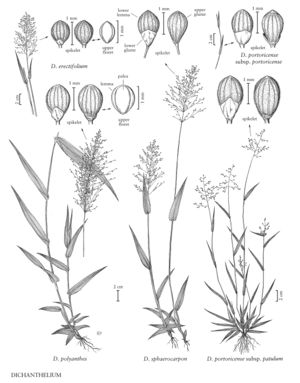Dichanthelium polyanthes
Plants cespitose, with few culms per tuft. Basal rosettes well-differentiated; blades 3-8 cm long, often to 2 cm wide, ovatelanceolate. Culms 30-95 cm, nearly erect, fairly stout; nodes glabrous or puberulent; internodes usually glabrous; fall phase with few, long-ascending branches, sparingly rebranched, branches arising mostly near the base of the culms. Cauline leaves 4-7; sheaths shorter than the internodes, mostly glabrous, margins ciliate; ligules vestigial; blades 10-25 cm long, 14-25 mm wide, thick, firm, often light green, veins evident (some more prominent than others), bases cordate, with papillose-based cilia, margins whitish, cartilaginous. Primary panicles 7-20 cm, less than 1/2 as wide as long, exserted. Spikelets 1.3-1.7 mm, broadly ellipsoid-spherical, often purplish at the base, puberulent. Lower glumes 0.4-0.7 mm, acute to obtuse, upper florets 1.1-1.4 mm, broadly ellipsoid, blunt. 2n = 18.
Discussion
Dichanthelium polyanthes grows in woods, stream banks, and ditches, and is restricted to the eastern United States. It occasionally hybridizes with D. sphaerocarpon.
Selected References
None.
Lower Taxa
No values specified."usually distinctly longer and narrower" is not a number."decumbent" is not a number.
